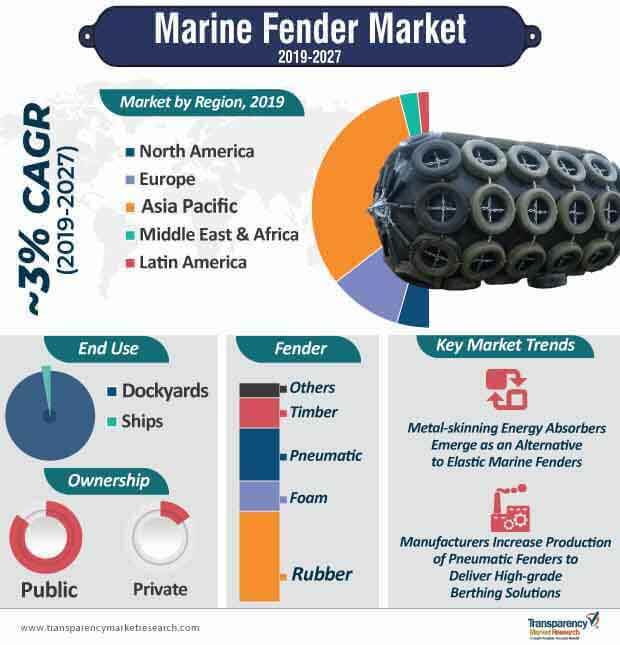
Transparency Market Research has published a new report on the global marine fender market for the forecast period of 2019–2027. According to the report, the global marine fender market is projected to reach a value of ~US$ 880 Mn by 2027, expanding at a CAGR of ~3% during the forecast period.
Global Marine Fender Market: Key Findings
According to the report, the global marine fender market is likely to be driven by the expansion of international trade and increasing port terminals in major developing nations.
Stringency of regulatory norms for seaborne trade is one of the prominent factors responsible for the expansion of the global marine fender market.
Rubber fenders are key fender types, and this segment is likely to hold a noteworthy share of the global marine fenders market during the forecast period. However, there has been a rise in the popularity of foam and pneumatic fenders in the market.
Planning To Lay Down Future Strategy? Request Sample https://www.transparencymarketresearch.com/sample/sample.php?flag=S&rep_id=37565
Expansion of Global Marine Fender Market
North America and Europe are witnessing an expansion of manufacturing, raw materials, electronics, oils & chemicals, agriculture, and textiles & apparel industries, which is driving their economic development. Moreover, the transportation of products and goods by means of waterways plays an integral role, as this mode of transport is cost-effective and energy-efficient as compared to other modes.
Booming industrialization and globalization led to the expansion of existing vessel ports and harbors in order to enhance the capacity of cargo transportation. Moreover, new vessel terminals are being developed by various developing nations, owing to the rise in bilateral trade, which is driving the market for marine fenders.
In 2017, global seaborne trade witnessed a significant 4% growth, the fastest in the past five years. It is projected to grow at a considerable rate of ~4% in the near future. Moreover, a surge in imports and exports is anticipated to aid in the development of vessel terminals and ports. This is estimated to boost the global marine fender market.
Based on fender, the global marine fender market has been classified into rubber, foam, pneumatic, timber, and others. The rubber marine fender segment held a significant share of global market. However, foam and pneumatic fenders are gaining popularity due to their cost effectiveness and high life expectancy. Pneumatic fenders are a type of rubber fenders that are hollow and filled with air. These fenders are preferred in ship-to-ship transportation applications.
Curious? Request To Access Market Data Marine Fender Market
Regional Analysis of Global Marine Fender Market
In terms of region, the global marine fender market has been divided into North America, Europe, Asia Pacific, Middle East & Africa, and Latin America. Asia Pacific held the largest share of the global marine fender market in 2018, due to the presence of a large number of ports in China and the ASEAN region. Moreover, rise in international trade in China and Singapore is expected to boost the growth of the market for marine fenders during the forecast period, as increase in trade is likely to drive port authorities to expand port terminals.
Global Marine Fender Market: Key Players
Prominent players operating in the global marine fender market include ANCHOR MARINE & SUPPLY, INC., Bridgestone Corporation, INMARE, J.C. MacElroy Company, Inc., Lalizas Italia s.r.l., MARINE FENDERS INTERNATIONAL, INC., Trelleborg Marine Systems, SHIBATA INDUSTRIAL CO., LTD., THE YOKOHAMA RUBBER CO., LTD., Sumitomo Rubber Industries, Ltd., and Urethane Products Corporation.
More Trending Reports by Transparency Market Research –
Collapsible Metal Tubes Market https://www.globenewswire.com/news-release/2019/05/07/1818256/0/en/Collapsible-Metal-Tubes-Market-worth-US-1-550-8-Mn-in-2025-Booming-Demand-in-Pharmaceuticals-Drives-Growth-TMR.html
Comments
Post a Comment